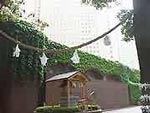 |
Best
of Japan |
Shinto,
which means the way of the gods, is not exactly a "national religion",
but rather one that influences almost every aspect of Japanese culture
and society. It has neither a founder nor sacred scriptures, like
sutras or the bible. Preaching or propaganda is also not common,
as Shinto is already a part of the Japanese people's lives. All
Japanese people are Shinto by the fact of their birth.
 The
"kami" are objects of worship in Shinto. They are sacred spirits
and can take various forms, such as natural elements (sun, trees,
and the wind) or abstract things (fertility, ancestors, and national
heroes). The
"kami" are objects of worship in Shinto. They are sacred spirits
and can take various forms, such as natural elements (sun, trees,
and the wind) or abstract things (fertility, ancestors, and national
heroes).
Shinto
is a very optimistic belief. It is thought that all humans are good
and that evil spirits causes all evil. Most of the rituals are performed
to avoid evil spirits through purification, offerings, and prayers.
The Confucian ethics had blended in with Shinto over the centuries,
although there is no confirmed written code of morals and ethics
in the Shinto religion.
 It
is the duty of the Shinto priests to perform rituals. Although they
are considered private people, they are allowed to marry and have
children. Female priests are also accepted in the Shinto religion.
It is customary for young ladies, or miko, dressed in white kimonos
to support these priests in performing the rituals. The miko must
be unmarried, and more often than not, they are the daughters of
the priests. It
is the duty of the Shinto priests to perform rituals. Although they
are considered private people, they are allowed to marry and have
children. Female priests are also accepted in the Shinto religion.
It is customary for young ladies, or miko, dressed in white kimonos
to support these priests in performing the rituals. The miko must
be unmarried, and more often than not, they are the daughters of
the priests.
Most
people seek support, protection, and good fortune at shrines before
important events, such as the opening of a new business. One should
never visit a shrine if they are feeling unwell, have an open wound,
or are mourning, as these things are considered impure.
 Amulets,
charms, and postcards can also be bought for a small fee. Pieces
of paper that predict your fortunes can also be bought. If you tie
the piece of paper to the branch of a tree, good fortune will come
true or predicted bad luck can be avoided. Wishes can also be written
on small wooden plates, which are then left on the shrines. Amulets,
charms, and postcards can also be bought for a small fee. Pieces
of paper that predict your fortunes can also be bought. If you tie
the piece of paper to the branch of a tree, good fortune will come
true or predicted bad luck can be avoided. Wishes can also be written
on small wooden plates, which are then left on the shrines.
There
are a few set patterns when praying at Shinto shrines or at home.
One of them is to purify yourself by cleaning your hands and your
mouth with clean water. You then give your offerings, such as coins
at a public shrine or food at home shrines, bow twice deeply, clap
your hands twice, bow deeply once more, and pray.
 Shinto
shrines are places of worship and the dwellings of the kami. Sacred
symbols, which represent the kami are stored in the innermost chamber
of the shrine where they cannot be seen by anyone. A torii, the
entrance gates to a shrine, is a characteristic element of Shinto
shrines. It separates the secular world from the spiritual. Shinto
shrines are places of worship and the dwellings of the kami. Sacred
symbols, which represent the kami are stored in the innermost chamber
of the shrine where they cannot be seen by anyone. A torii, the
entrance gates to a shrine, is a characteristic element of Shinto
shrines. It separates the secular world from the spiritual.
A
shrine usually includes an innermost chamber and an offering hall,
along with other buildings, such as the priest's accommodations,
a stage, and auxiliary buildings. However, Shinto shrines do not
include a cemetery, as death is thought to be evil. In fact, most
Japanese cemeteries are found in Buddhist temples.
The
most significant features in Shinto art are the architecture of
the shrines and the cultivation and preservation of ancient forms,
such as Noh theater, calligraphy, and court music. However, most
Shinto shrines are a combination of both the shrines' and Buddhist
temple's architecture. Only a few Shinto shrines are considered
pure Japanese style. The Great Shrines
at Ise and the Itsumo Shrine are such examples.
Top
of Page
|
